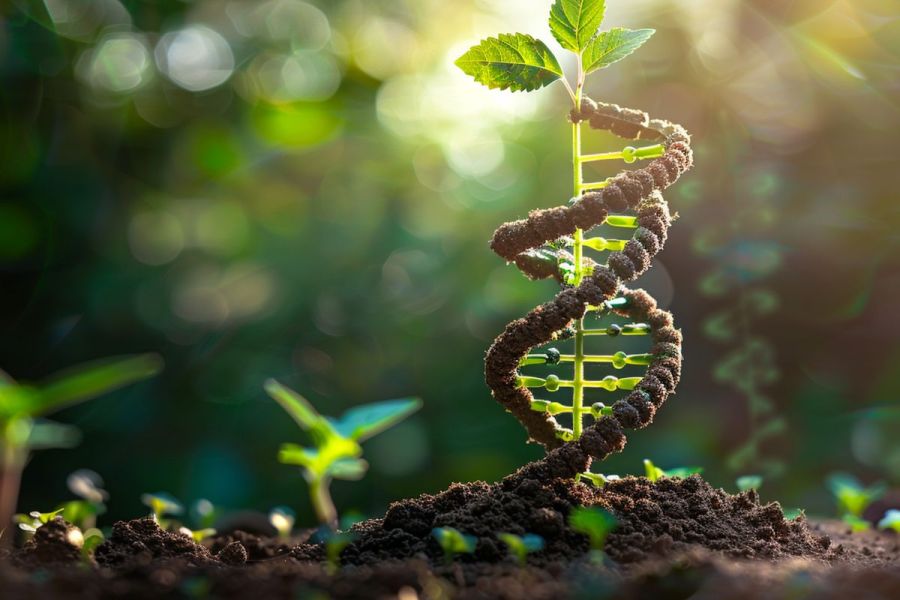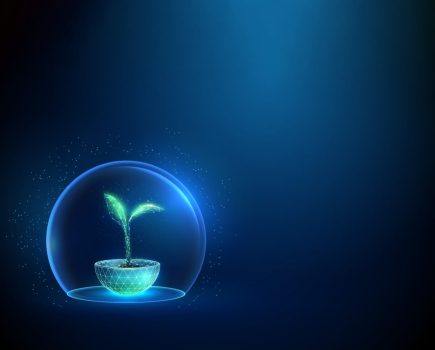As technology continues to drive innovation in agriculture, CPM takes an in-depth look at how genomics could help growers to get more from alternative crop inputs like biostimulants.
“The hope is that with the aid of this technology, we can bridge the cynical past with reliable science and create solutions for the future.” – JOHN HAYWOOD
By Charlotte Cunningham
Those au fait with the livestock world will know that genomics have been used for some time to accelerate breeding programmes to focus on better productivity, sustainability and disease resistance, to name but a few advantages.
Now, this technology is breaking barriers in the arable sector – and could be the key to accelerating both plant productivity and input efficiency, believe experts.
A recent webinar, hosted by Unium Bioscience in collaboration with the British On-Farm Innovation Network (BOFIN) explored how plant genomics are driving innovation – encompassing everything from advanced biostimulants to sustainable strategies for boosting crop resilience and productivity.
“Unlike genetic modification, or gene editing techniques known as CRISPR, genomics is a field of science that uses genomic information to study how genes affect plant health and biological processes,” explained BOFIN founder, Tom Allen-Stevens. “It doesn’t alter DNA but analyses genetic data to unlock insights.”
BIOSTIMULANTS
Among the areas where this unlocking of information is proving beneficial is the biostimulant world. With more than 25 years of experience under his belt, Unium Bioscience’s John Haywood said it’s been his ambition during that time to lose the ‘snake oil’ image of the biostimulant and biological industry.
“We’ve used peer reviewed science and lots of independent data to create reliable solutions, but there’s always a cynicism that we face year-on-year which we have to overcome.
“Now, through partnerships with cutting-edge science, we can take this to the next level with genomic studies that link plant physiology, plant genetics, nutrition and the biostimulant/biological platforms to create solutions for farmers and growers.”
As Tom alluded to, John stressed that exploring genomics isn’t about changing genetics. “The best analogy for it, is that we’re going to learn how to read the book without changing the text. GMO and CRISPR may change the text, and they look to change the words, but what we’re wanting to do is read the book and read it at a more detailed level.”
John explained that by doing this, the industry will have access to quicker solutions to the problems which are arising and changing all the time. “That gives us a more targeted, accurate approach to achieve our objectives, but importantly, solutions which are reliable and robust. And now through this technology being lower cost, affordability for farmers.
“It’s a really interesting time because around 60- 70% of crop production losses are attributed to abiotic stress – or environmental stresses. This is compared with biotic stress – diseases, weeds or pests – which cause about 15-20% of losses.
“The reason why this is interesting, is that only around 40% of farmers are using products like biologicals to mitigate these abiotic stresses. So the hope is that with the aid of this technology, we can bridge the cynical past with reliable science and create solutions for the future.”
GENETIC EXPRESSION
Someone majoring in this area is Layne Ellen Harris of US-based Foresight Agronomics. The firm is a research consultancy with the goal of demystifying the use of biologicals by looking at how these products can influence genetic expression in plants.
Speaking during the webinar, she said: “Whenever we look at how products are affecting the expression of genes in a plant, we’re able to look under the surface. We’re able to look in real-time at what a product does and how a plant is perceiving what the application of it does – gene expression is one of the ways that we do that.”
Layne Ellen added that typically, when using biostimulants, farmers and agronomists stick to the equation of applying a certain product at the right time and getting an expected result. “But there’s a huge question mark on how does that get there – essentially, how does this product applied at this rate to these crops, at this time, actually get us to these expected results? That’s really where gene expression comes in.”
Describing this in its most basic form, Layne Ellen said that the genetic material of a plant is stored in the nucleus of the cell. “This is where the DNA is, so whenever we say that a gene is expressed, what it’s doing is accessing regions of DNA and reading it like a code.
“This is called the central dogma of molecular biology, which is essentially how information is transferred in a cell from DNA to RNA and then to a protein; there are lots of nuances and regulatory systems that the cells use to maintain and protect this pathway.
“But essentially, whenever a gene is expressed, for example, a plant is getting stressed and it has to access some of its abilities to deal with that, it will go and find regions of that DNA which have genes that code for proteins, giving that plant special abilities to deal with the stressor.”
In situations of drought, this might mean aiding the plant to not lose water or protecting some of the enzymatic functions in the cells, explained Layne Ellen. “So that gene or sequence is located in the DNA, but the DNA is stuck in the nucleus of the cell. When this process occurs, what happens is – in an amazingly efficient and elegant way – the DNA unwinds and a copy of it is made.
“That copy is essentially a little mobile version of the gene which can leave the nucleus of the cell and go to where it has to go to be translated into the enzyme or protein that this gene is actually the code for.”
Layne Ellen highlighted that it’s now possible to measure how many copies of these genes are being expressed and exactly what by using sequencing and tests like PCR. “In any typical plant, there are thousands of genes available in this library of DNA.
“What we can do through sequencing technology, and through understanding this central dogma of how genetic information is being accessed within the plant, is identify the mRNA, or messenger RNA. Then we can actually see what genes a plant is turning on, or turning down, in response to stress, to the developmental stage that it’s in, or in response to biological products that we put on it.”
Taking drought as an example again, Layne said there are certain triggers that happen when a plant experiences drought stress that activate lots of pathways in the plant. “These are both biochemical and genetic pathways. If we think about the result of this, of all these genes expressing, the plant now has the ability to resist some of the drought stress – to use its water more efficiently, or maybe continue to grow despite the stress.
“By identifying those genes, we can see if a product can elicit some of these same responses in a plant. As such, make it think that it’s being stressed but actually cause it to be more resistant to future stress down the road.
“So the idea of this type of approach is to really narrow in on what exactly products are doing to the plant and how that plant perceives that. And, we can measure it by the types of genes the plant is turning on or turning down in response to individual products.”
When this science is overlayed with some of the typical responses elicited with biologicals and biostimulants, farmers and agronomists can begin to be strategic with what they use and when, as well as incorporating other factors that fuel plant pathways, such as nutrition, she believes.
“Nutrients like calcium, phosphorus and potassium are involved here and they’re important pieces of this signal transduction that the crop has to have enough of, in order to perform certain functions and have the best ability to fully express these mechanisms.”
Building on this and turning focus to how it translates to the field, Helm Agro’s Tim Eyrich has been looking at the relationship between biostimulants and nutrition for the past few decades. “During the past five years in particular, being able to use genomic technology has meant our biostimulants are working more consistently and we’re now able to take this genomic data and put it into in-field decision making.
“Biostimulants and crop nutrition are dependently linked – we can’t separate them. If you use a biostimulant, there will be a group of nutrition that has to be present in the plant to allow that biostimulant to work at its highest possibility,” he said.
“Understanding this nutritional biostimulant interconnection has been possible through genomic work and we now have a very good understanding of what we have to do to get those 95-100% returns on investment from biostimulants. We’re not working in the dark anymore.
“Being able to understand what genes we’re having a positive effect on and what they actually do, allows us to create phenotypic plasticity where we cultivate the most optimised genetic plant for the environment that we’re growing in that given year and handle stress much better.”
Tim explained phenotypic plasticity as the ability of a plant to change to stimuli or inputs from its environment. Being able to manipulate this is particularly beneficial when trying to mitigate stress in plants, which can occur in many forms, he commented.
“The first thing we can look at is application timing and durability of the biostimulant to optimise its effect – information which is available through genomic investigation.”
Tim said this is likely to vary significantly depending on the purpose of the product. For example, something that increases nutrient uptake will behave differently to a product designed to improve nitrogen use efficiency.
Secondly, Tim added that it’s important to pair biostimulants up with their dependent nutrients, and work has shown that sulphate is particularly influential – although again, this will be product dependent. “We always used to think potassium was the most important water-stress nutrient, but new knowledge tells us that sulphate is now perhaps more important.”
He concluded: “Having genomics knowledge provides clear vision and insights into phenotypic plasticity that’s provided by a nutrient and/or biostimulant. Through this technology, we can better understand the correct time to apply the product and be accurate with the duration it’s likely to last for and when we may need multiple applications.
“As such, this can lead to a high return on investment and success rate with every single biostimulant you apply.
This article was taken from the latest issue of CPM. Read the article in full here.
For more articles like this, subscribe here.
Sign up for Crop Production Magazine’s FREE e-newsletter here.




